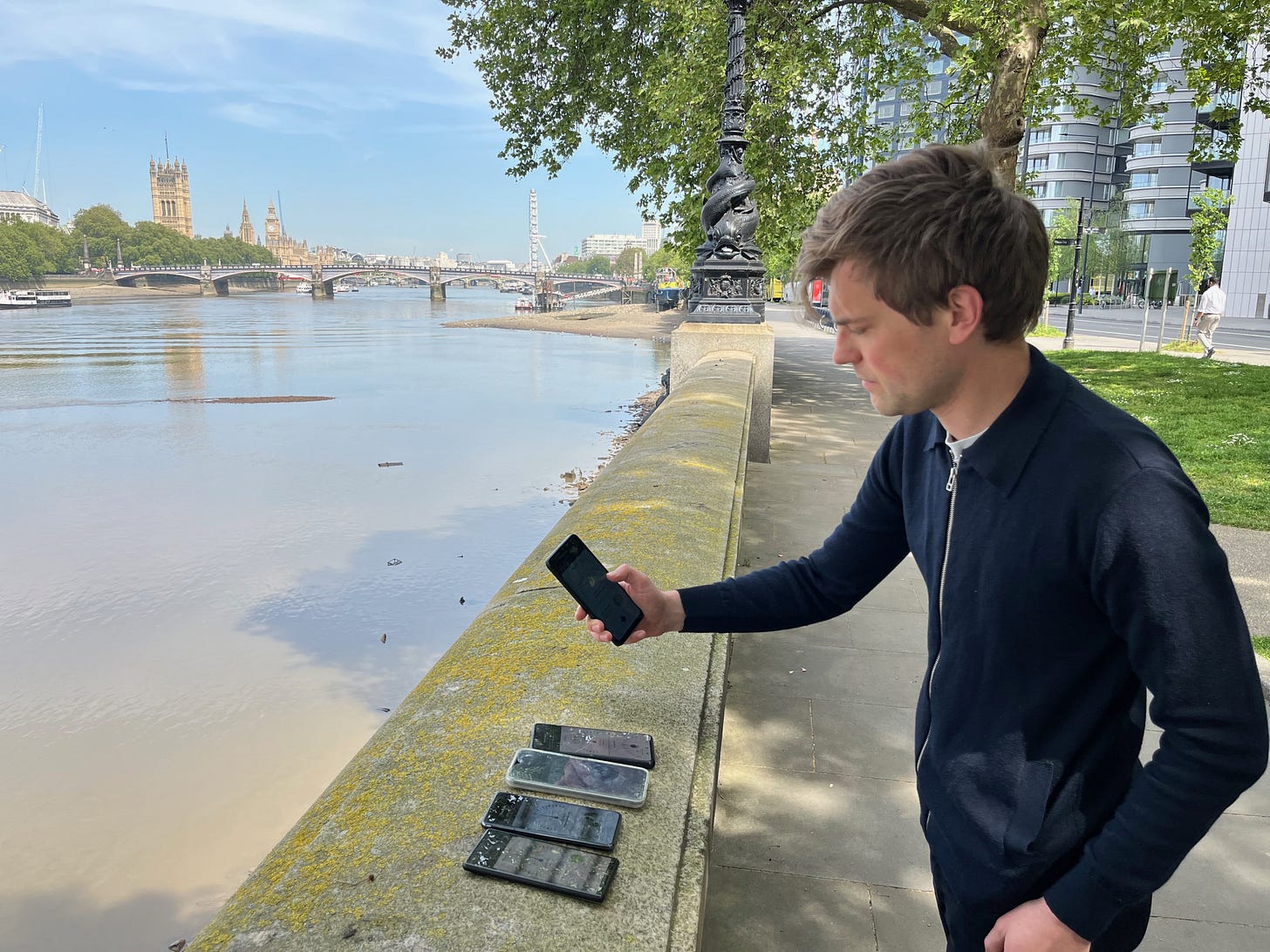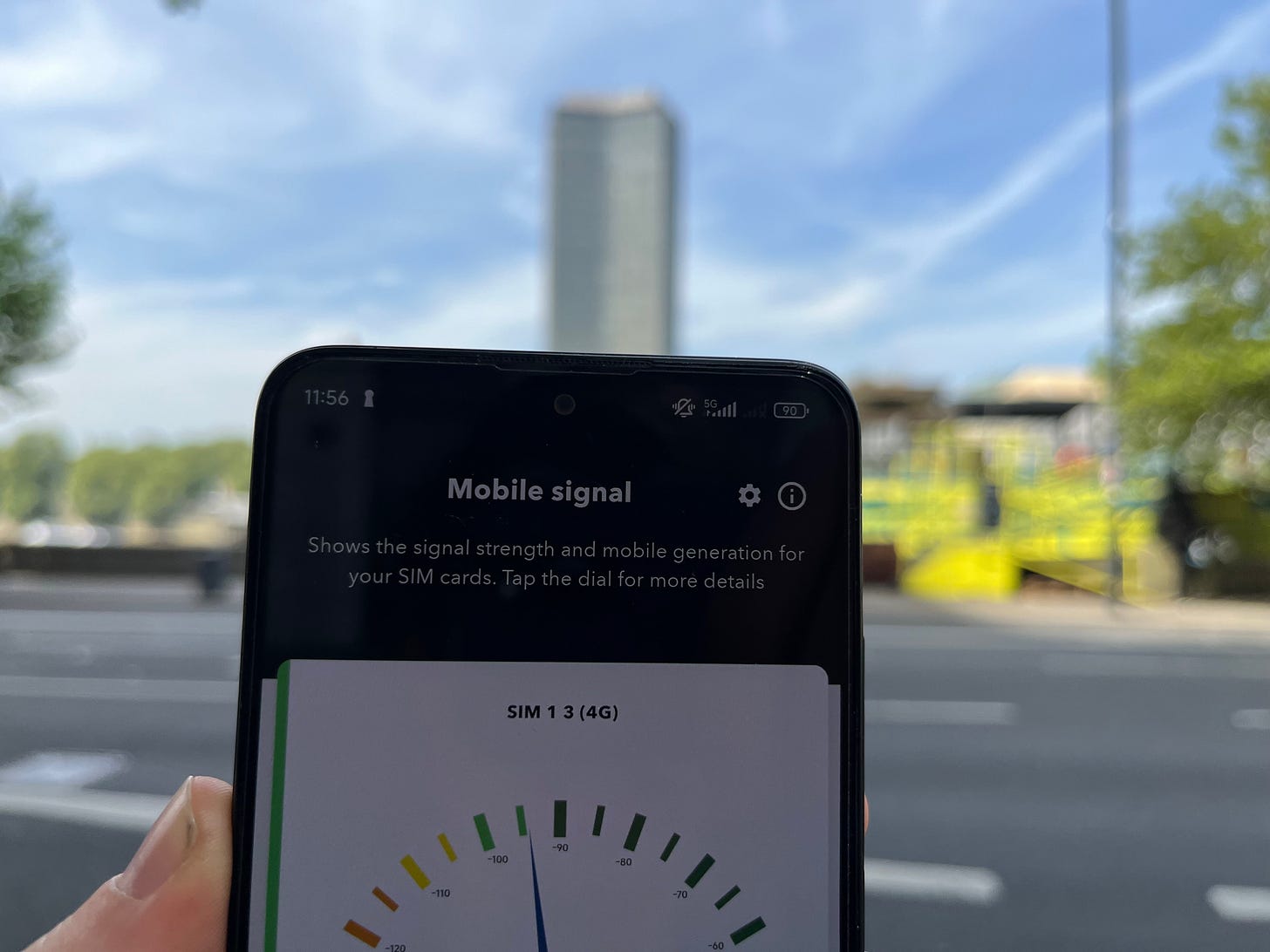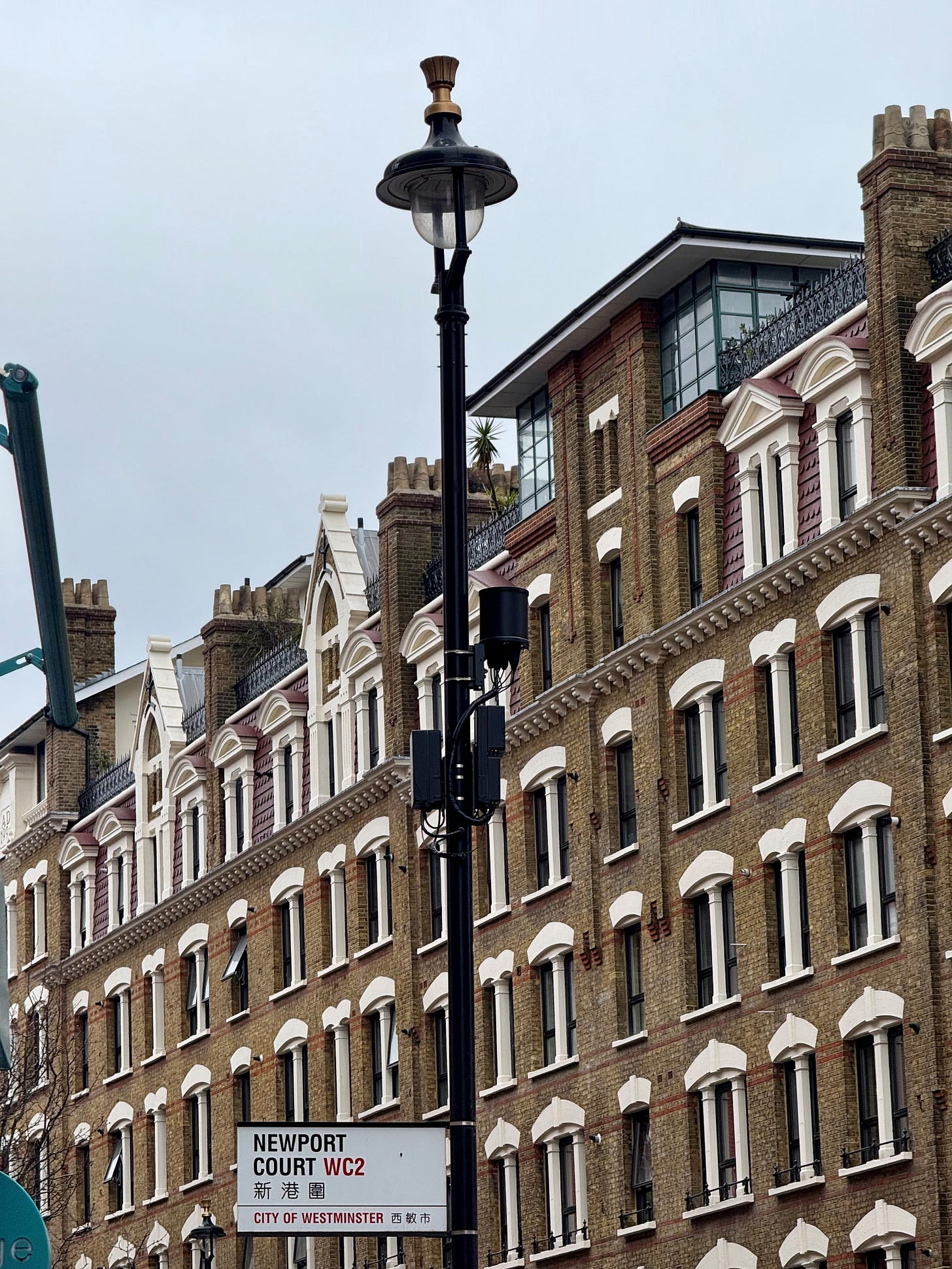The real 5G conspiracy: How Londoners are being lied to about their phone signal
Plus: We reveal how much the capital's councils actually make from festivals in their parks.
It’s a situation so brazen that it seemed implausible when London Centric was first told about it.
Could millions of Londoners really be told by their phones that they are connected to modern 5G mobile data networks when they are unknowingly stuck running their work and social lives over 4G? Could that little icon in the top corner of your phone screen really be deceiving you?
When London Centric previously reported on terrible phone data connections in the capital we received a huge response. Many readers learned for the first time why you can have high levels of mobile phone coverage (as shown by the signal bars on your phone screen) but no functioning data download capacity.
But then one London company got in touch to claim the situation is even worse.
Scroll to the end to read the story.
How much did your local council make from festivals in parks?
One missing detail in the Battle for Brockwell Park and the wider issue surrounding festivals in London’s public spaces is a definitive answer on how much local councils are making from such events. Are the local councils renting out their parks getting ripped off by the international festival operators and private equity companies who own the festivals?
London Centric put in a series of freedom of information requests, and this is what we learned:
Haringey Council earned £1.34m from events in Finsbury Park – home to Festival Republic’s Wireless Festival and the Krankbrother-operated series of concerts.
Southwark Council (Peckham Rye, Burgess Park, Southwark Park) will earn a projected £440,000 from events in its parks in 2025, up from £340,000 in 2024. Events include GALA Festival in Peckham Rye, August’s Boiler Room, Jazz Café and Maiden Voyage in Burgess Park, and RALLY festival in Southwark Park.
Tower Hamlets (Victoria Park) declined our request on commercial grounds. In a November 2023 council meeting, it predicted that “commercial event activity in parks and open spaces” could increase to £1.9m in 2024/25.
Ealing and Hounslow councils run Gunnersbury Park, which is operated through a separate entity. This year it is hosting the annual Waterworks festival and five days of Festival Republic concerts, featuring Supergrass, the Libertines, and the Smashing Pumpkins. Similar events raised over £700,000 in 2023/24.
Lambeth Council (Brockwell Park), declined to answer our request on commercial grounds. However, a previous request shows that the council earned £930,000 from events in its parks in 2023, including £510,000 from Brockwell Park – already the venue for five paid Brockwell Live events, among them Wide Awake and Mighty Hoopla – and £210,000 from Clapham Common.
The Royal Parks (Hyde Park, Greenwich Park, Richmond Park, etc) is the charity that manages eight open spaces that once belonged to the monarchy. It blew all the other councils out of the water by earning an astonishing £31m from events such as Hyde Park’s British Summer Time concerts and the six-week-long Winter Wonderland event in 2023/24.
Also, while we’re at it, for all the online fury it turns out that most Londoners are… basically fine with the principle of private festivals in public parks?
Polling for London Centric by More in Common found that 67% of Londoners think such events are “good for the local community by bringing jobs, income, and entertainment to the area”, with just 14% actively believing they are bad for the local community. (We envy the chunk of the population who are happy to avoid taking a stance altogether.)
Support for the festivals was broadly the same across all political parties and age groups but we were intrigued by this supplementary UK-wide question — which suggested Gen Z live up to their straight-laced stereotype by being more sympathetic to concerns about loud noise than their millennial predecessors.
Ed Hodgson, associate director at More in Common said although the polling suggests people are supportive of festivals this does not mean “the average Brit is a die-hard YIMBY of the sort common on certain corners of social media” and they want to see festival organisers and councils manage noise complaints.
London Centric’s reporting is paid for by people who are willing to support traditional, on-the-ground journalism about the capital. If you haven’t joined already and are willing to become a paid subscriber then your support is much appreciated.
London Centric investigates: Why London’s 5G signal might be built on lies.

Martin Sims is an unlikely drug dealer. But as he wanders along the Albert Embankment near Vauxhall station carrying five different mobile phones, he gets curious glances from people wondering if he is running a global crime network through a series of burner devices.
Sims is using his various SIMs to carry out signal tests on different mobile networks. And the founder of mobile spectrum consultancy PolicyTracker has concluded that Londoners are being widely deceived about their ability to access modern 5G data networks.
Tests using his company’s SignalTracker app have found that around 40% of the time that a mobile phone in central London shows a logo suggesting a user is accessing data over the modern, potentially faster 5G network it is, in reality, only able to access the older, slower 4G network.
“It’s not good to say something is something when it isn’t,” said Sims, by way of explaining the issue.

In the same way that the bars on your phone reflect whether you’ve connected to a phone mast, rather than whether or not the mast has the capacity to provide you the data connection you need, the 5G icon might only indicate that the latest technology is theoretically available in your area.
“The 5G icon on your phone doesn’t actually show you’re connected to the 5G signal,” said Sims. “It shows 5G is potentially available but you’re not necessarily connected to it.”
The issue is particularly acute in the capital where data capacity is under strain, as too many people try to connect to masts that can’t handle the demand.
A spokesperson for media regulator Ofcom confirmed to London Centric it is aware of the issue. “Handset design determines when a 5G icon will be displayed, and with some older 5G technology it's sometimes difficult for phones to distinguish between whether 5G or 4G services are being used.”
Londoners are fed up with the poor quality of their mobile networks struggling to provide the data capacity that’s central to our modern work and social lives. London Centric has previously reported on how factors such as campaigners’ objections to installing new masts on conspiracy grounds, technology shortages caused by the forced removal of Chinese-made Huawei telecoms equipment, and a planning system that makes it hard to install masts on listed buildings have combined to leave parts of central London as a data download dead zone.
When the capital fills up with people, the download speed collapses.
Go out in Soho or Covent Garden on a Saturday night and you’ll struggle to access enough data to even open a WhatsApp message, let alone upload a picture to Instagram. If you take a train out of Waterloo through the suburbs of south west London then the signal collapses because local residents have objected to new masts along the route. The cost of installing telecoms equipment is rising, masts are being taken off old buildings due to redevelopment, and London is being left behind in the race to build data capacity.
“Networks were built for rapidly deploying 2G coverage decades ago, not for a 12 carriage Thameslink full of people doing Zoom meetings”
As London Centric carried out tests with Sims in central London, we watched multiple phones stay on the 4G network, while continuing to show the 5G logo in the top corner of the screen.
Most of the UK’s mobile networks were reluctant to comment on the record but, in general, they accept that in cities such as London where it is difficult to install new equipment, users may well not be receiving the 5G connection they think they are.
To get technical, there are really two types of 5G in use in the UK. The first is called 5G-NSA (short for “not standalone”) which was introduced around five years ago and is partly built on top of the old 4G network. Then there is 5G-SA (short for “standalone”), which has only started to be rolled out by British networks over the last year and will ultimately solve this issue.
At the moment, people with access to 5G-NSA might find themselves bumped down to 4G – something most mobile phone customers are not aware of.
Sims’ app only works on Android devices, although iPhone users can access raw data about their connection if they dial *3001#12345#* on their phone app keypad and look for letters such as ‘NSA’ or ‘SA’.
Peter Clarke, a telecoms analyst who specialises in extraordinarily detailed posts about mast technology in the UK, agrees that the issue is very real: "Is it possible to have a 5G icon and your device not use 5G? Yes.”
Clarke said you can “get into a complicated niche debate about what these bars and icons mean” and in many cases, whether for reasons of battery use or ensuring a stable connection, it may be better for the user to be on the older technology.
He feels the real challenge is the refusal of London locals, councils, and landlords to make it easy to install new telecoms masts. For most people, he said, what matters is being able to do what they want on their phones even if they’re in a busy train station or public place: “The issue in London is the networks can’t deliver even basic experiences of what a network should provide in too many places, too much of the time.”
He added: “It depends a lot on what network and device and what software version your device is using. Networks were built for rapidly deploying 2G coverage decades ago, not for a 12 carriage Thameslink full of people doing Zoom meetings and TikTok at 8.30am.”
“Mobile networks have sold themselves as Lamborghinis but they should also be selling themselves as good and reliable”
The situation is not set to improve in the near future. A recent independent report for the mobile phone industry concluded that, although phone companies are expecting to have to invest £9bn in improving the UK’s 5G network by 2030, growing demand could require a further £3-£5bn to be found. And to deliver the full capabilities of 5G in urban locations like London “would imply still larger investment gaps”. Technological advances in the city in the next decade, such as more driverless cars (already on the roads in cities like San Francisco or Singapore) or other autonomous technologies, could only make the problem worse.
Clarke, the telecoms analyst, argued that another issue is that Brits are reluctant to spend money on their data package, meaning the networks don’t have the incentive to invest: “Talking to people on the street they often are very price-focussed. They spend £3 or £4 a day on a coffee but will go with [a phone network] that’s a few pence cheaper a month.”
The networks are privately happy to accept this argument, although in public it’s hard to suggest their customers should pay more to major corporate businesses if they want a reliable network.
Some are nonetheless making investments in central London. EE this week announced plans to install 80 small masts on lampposts in central London, with small cells attached to lampposts in areas such as Chinatown in a bid to fill the gaps in existing coverage.
Ultimately, the public’s desire for flashy headline-grabbing technology might be to blame, argued Sims: “It’s more beneficial to individuals to have a consistent, reasonable speed. Mobile networks have sold themselves as Lamborghinis but they should also be selling themselves as good and reliable. That’s probably more helpful to most people than the focus on the very high speeds.”
Media regulator Ofcom said: “Providers don't typically charge more for 5G, but customers should make a complaint if their service isn't as expected.”
Sims acknowledged that, while his testing shows a potential consumer scandal where people receive 4G connections while believing they are connected over 5G, it’s a difficult issue to explain to the general public: “Operators and manufacturers could be more straightforward about whether you’re actually getting 5G or not.”
He said: “One of the things on which networks are sold is download speed, which is helpful but not as important as coverage. Mobile operators have made a bit of a rod for their own back by emphasising speeds — then people complain that they’re not getting them.”
Got a story for London Centric? Get in touch via WhatsApp or email, or leave a comment.
Feedback is always appreciated via WhatsApp or email, or leave a comment.









Just slightly pre-emptively, I know this is a very very complicated topic and the technical issues around spectrum usage are sometimes hard to unpack. (I’ve spent days talking to people who have been very generous with their time on this one.)
So please do get stuck in to the comments but bear in mind this is aimed at a general audience full of people (like me) who might be surprised that were promised one thing and are perhaps getting a very different thing.
Appreciating the nominative determinism.